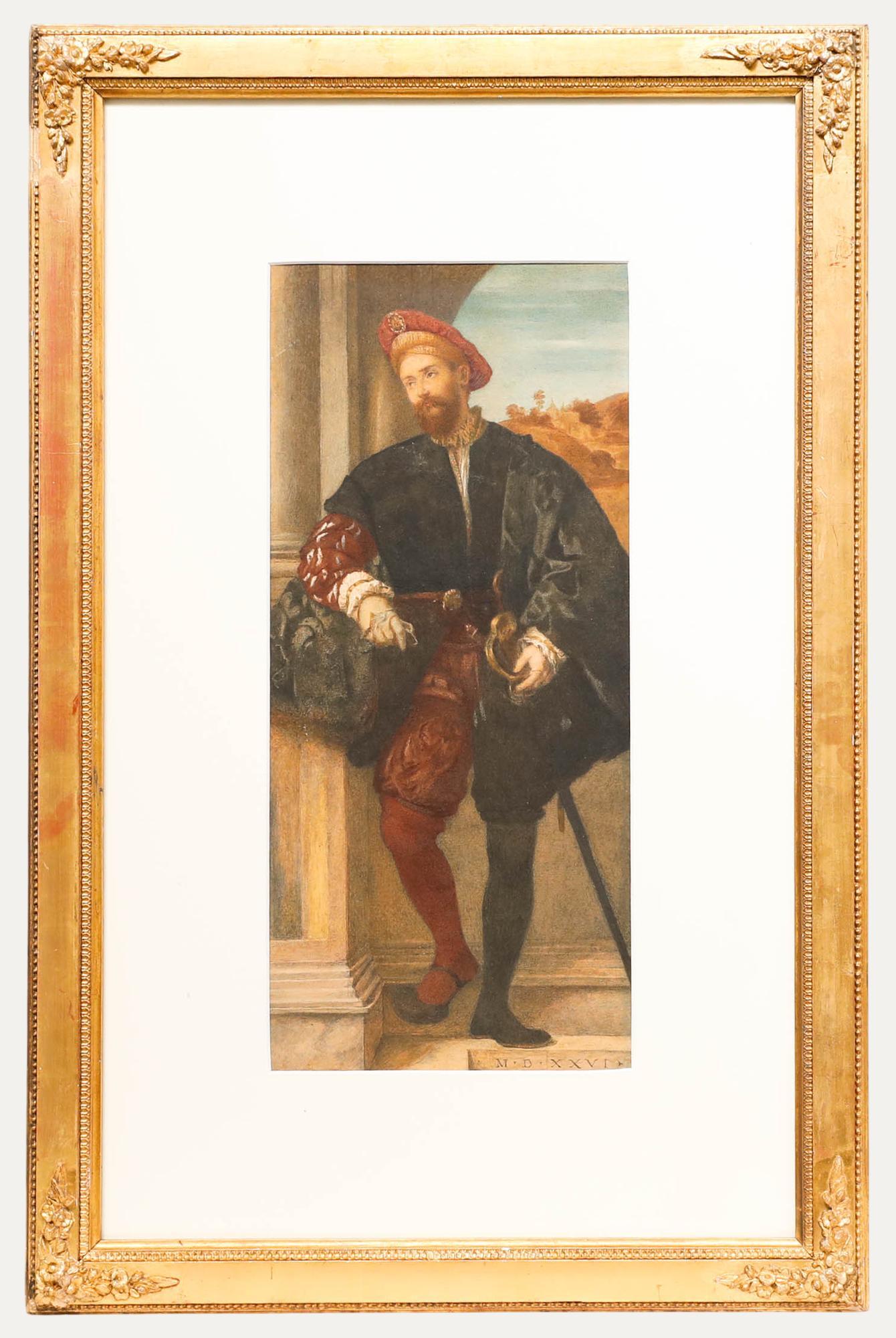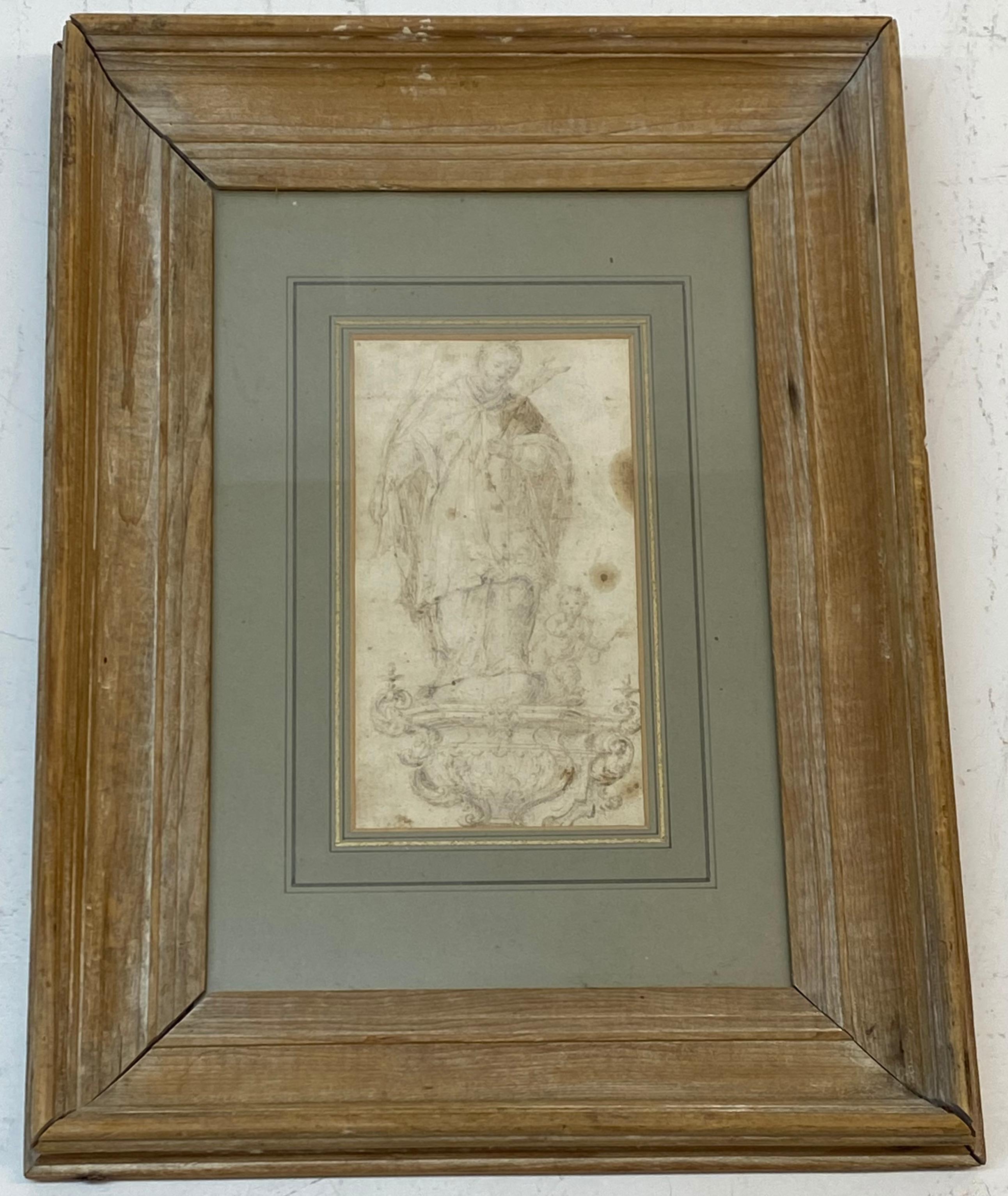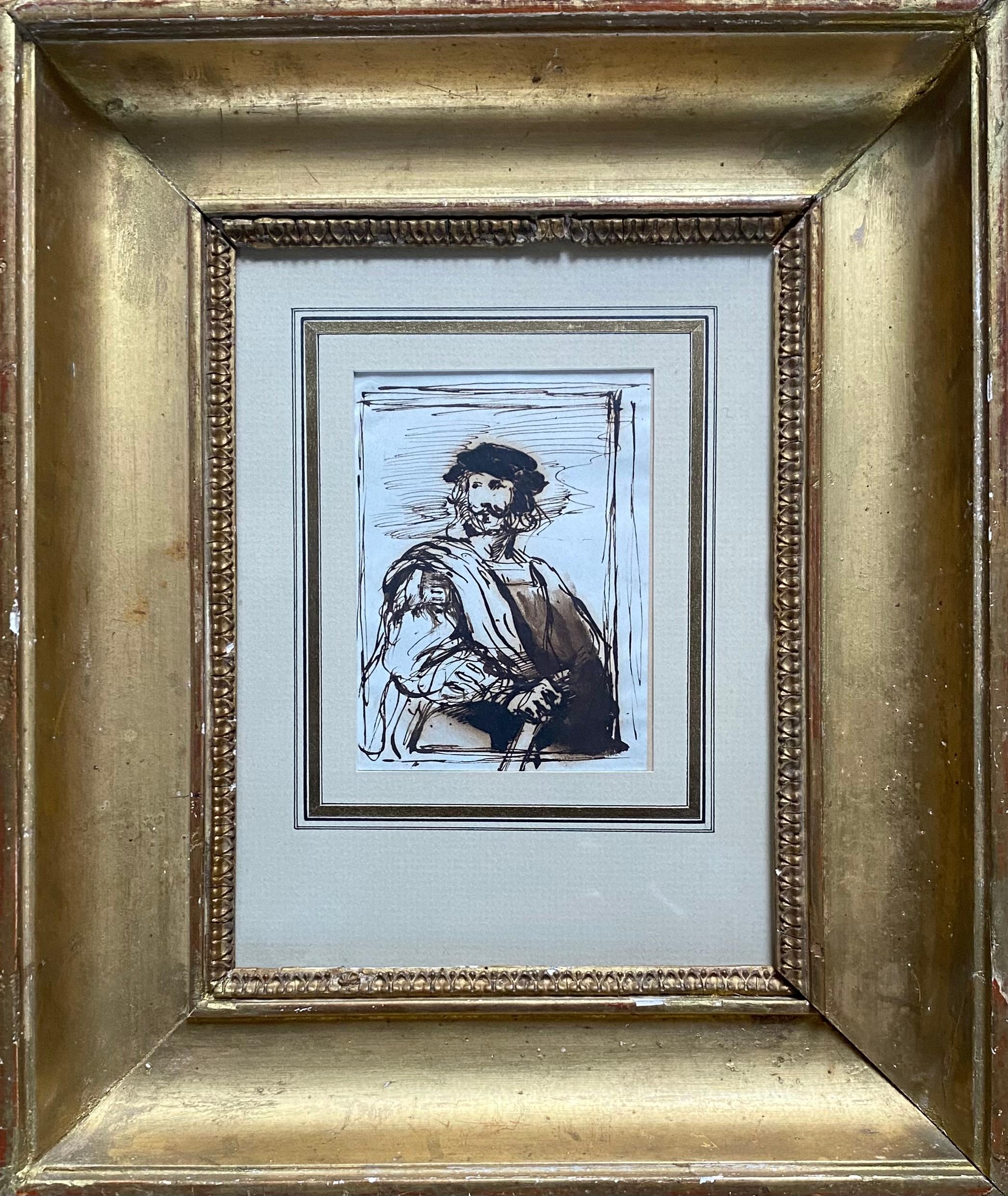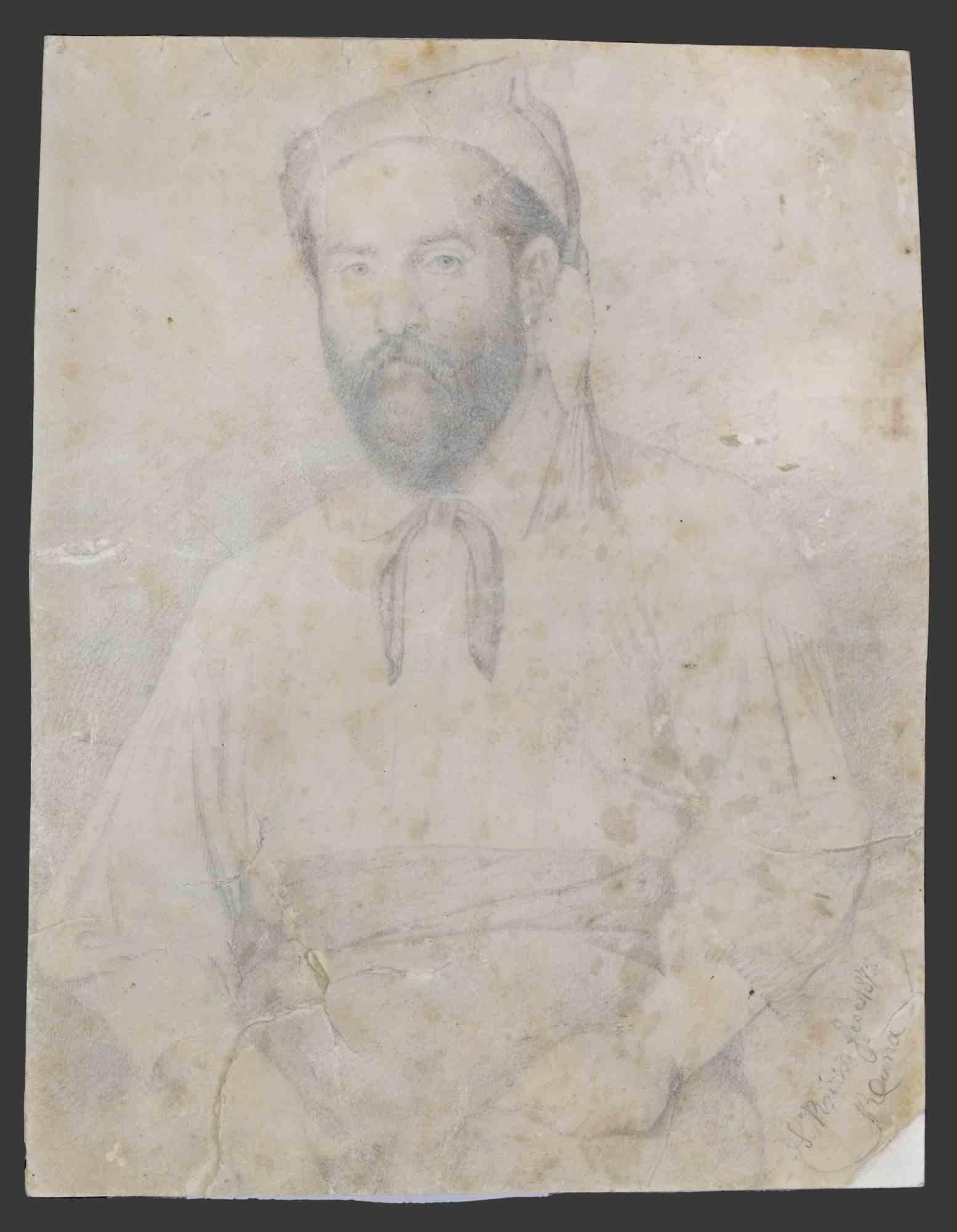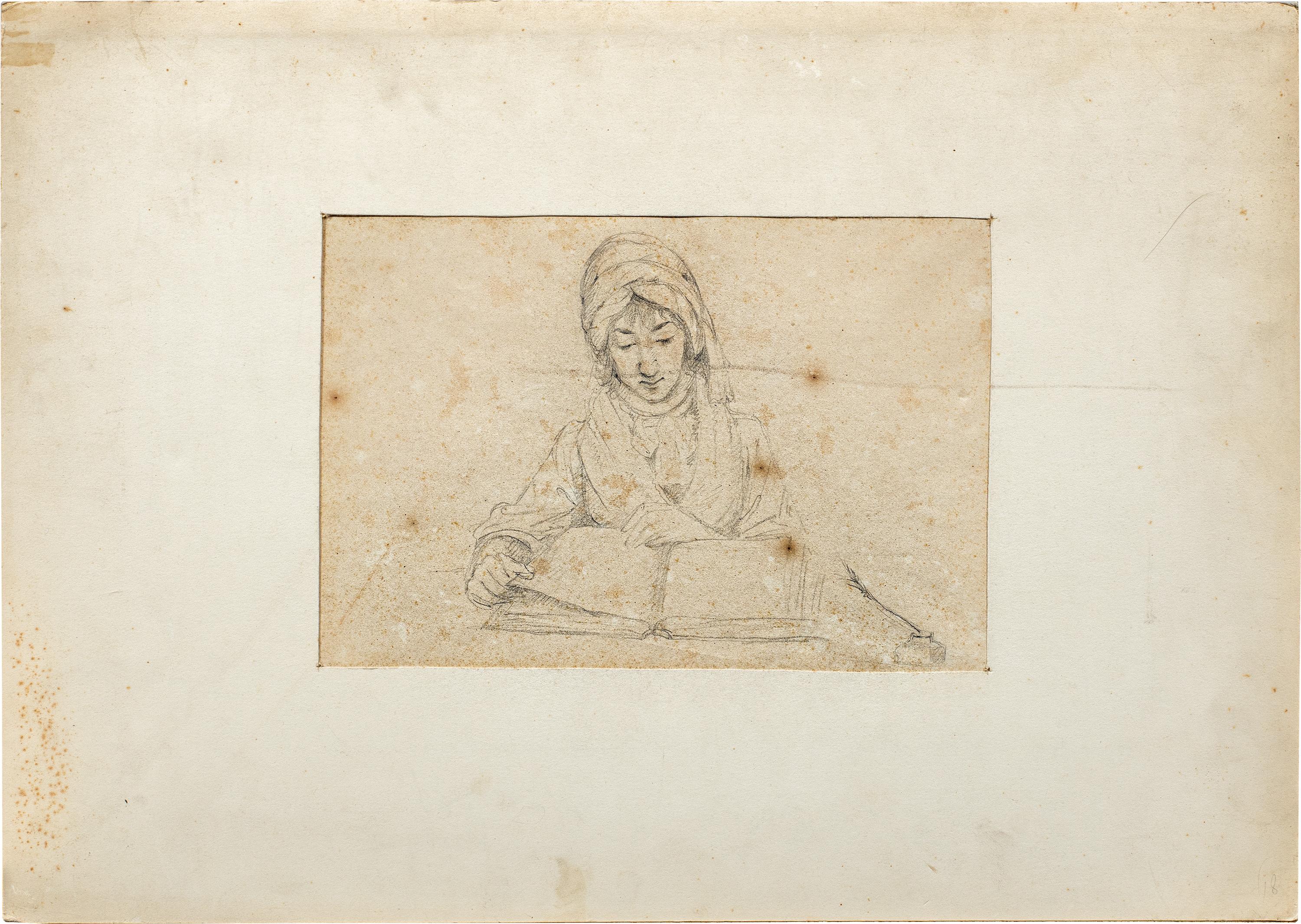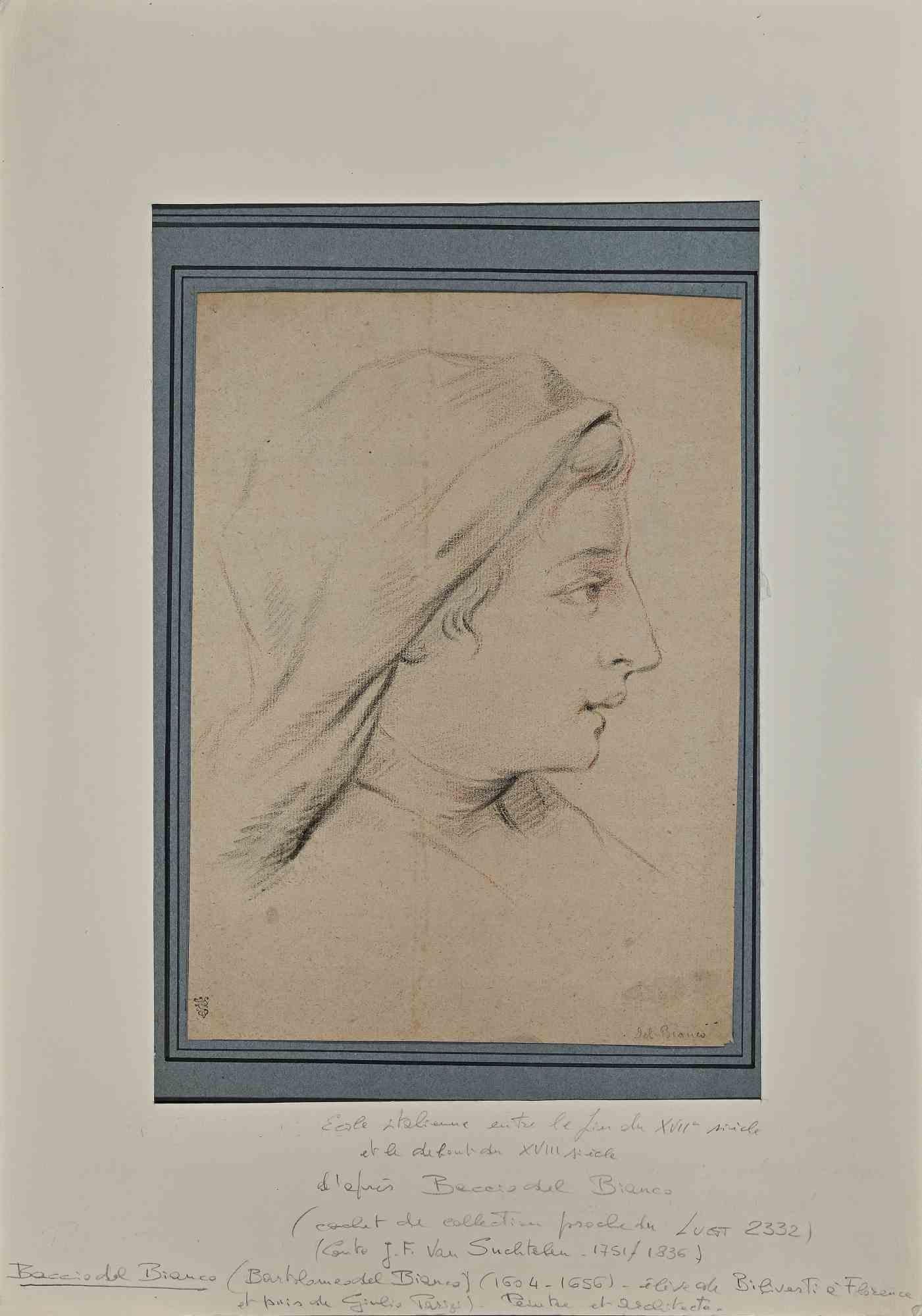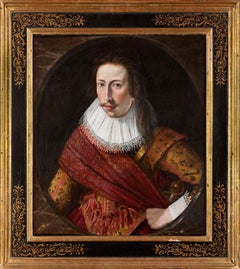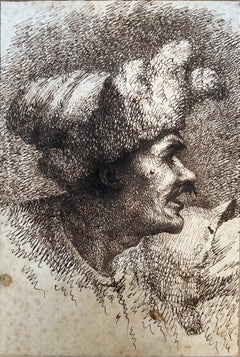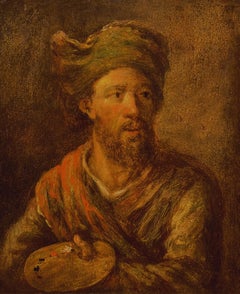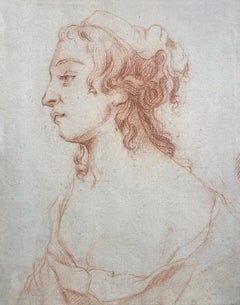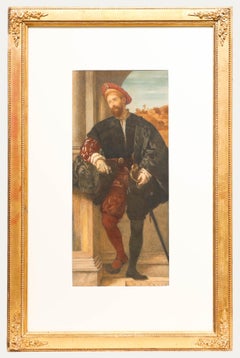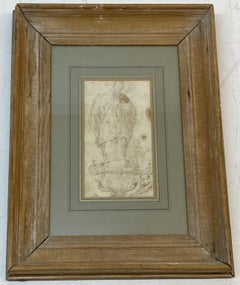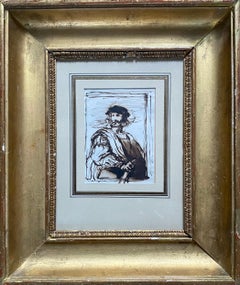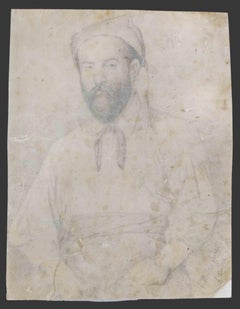Items Similar to Portrait of a Merchant
Want more images or videos?
Request additional images or videos from the seller
1 of 6
Portrait of a Merchant
$19,761.27
£14,400
€16,931.38
CA$27,284.88
A$30,256.92
CHF 15,897.77
MX$369,688.10
NOK 198,902.73
SEK 186,704.20
DKK 126,396.06
About the Item
Giovanni Francesco Barbieri Guercino
Italian 1591-1666
Portrait of a Merchant
Sanguine on laid paper
Image size: 12 ¾ x 16 inches (32 x 40.5 cm)
Wash mount and period frame
This fine work is after a drawing by Giovanni Francesco Barbieri Guercino, Italian, (1591-1666), which is part of the National Museum collection in Sweden.
This red chalk drawing on light brown paper, clearly shows the careful hatching and crosshatching in by the artist. The unknown sitter is physically present, even from side profile. The hat and jacket give a sense of wealth but not extravagance.
His hat is of a type that one sees in other portraits by Bartolomeo Passarotti and other contemporaries. The man’s pronounced nose, facial hair, and angular features are captured with an immediacy. The heavy eye lids and posture give him an air of authority.
There is another copy of the drawing in the Royal collection at Windsor Castle.
- Dimensions:Height: 12.75 in (32.39 cm)Width: 16 in (40.64 cm)
- More Editions & Sizes:1 of 1Price: $19,761
- Medium:
- Movement & Style:
- After:Giovanni Francesco Barbieri (Il Guercino) (1591 - 1666, Italian)
- Period:
- Condition:
- Gallery Location:London, GB
- Reference Number:1stDibs: LU52412009262
About the Seller
5.0
Vetted Professional Seller
Every seller passes strict standards for authenticity and reliability
Established in 2007
1stDibs seller since 2014
82 sales on 1stDibs
Typical response time: 3 hours
- ShippingRetrieving quote...Shipping from: London, United Kingdom
- Return Policy
Authenticity Guarantee
In the unlikely event there’s an issue with an item’s authenticity, contact us within 1 year for a full refund. DetailsMoney-Back Guarantee
If your item is not as described, is damaged in transit, or does not arrive, contact us within 7 days for a full refund. Details24-Hour Cancellation
You have a 24-hour grace period in which to reconsider your purchase, with no questions asked.Vetted Professional Sellers
Our world-class sellers must adhere to strict standards for service and quality, maintaining the integrity of our listings.Price-Match Guarantee
If you find that a seller listed the same item for a lower price elsewhere, we’ll match it.Trusted Global Delivery
Our best-in-class carrier network provides specialized shipping options worldwide, including custom delivery.More From This Seller
View AllPortrait of an Officer, Cornelius Johnson, 17th Century Old Masters
By Cornelius Johnson
Located in London, GB
Circle of Cornelius Johnson
Circa 1620’s
Portrait of a Officer
Oil on canvas
Image size: 28 x 24 inches
Period style hand made frame
Provenance
Private European Estate
This striking portrait dates to around 1620, as you can see from the images of the sash the detail is very high. The sash is decorated with gold thread and would have cost a small fortune at the time. Sashes were originally developed for a military function (making officers more visible for their men during combat), but soon became a primarily male fashion...
Category
Early 17th Century Old Masters Portrait Paintings
Materials
Oil
Sketch of a Man in Profile
Located in London, GB
Sketch of a Man in Profile
17th Century French School
Ink on paper
Image Size: 10 1/2 x 7 inches (26.5 x 17.5 cm)
Framed
Provenance
The estate of Joseph McCrindle
Christies Old Masters and British Pictures and Old Master Drawings Sale 12th December 2008
This highly worked picture shows us a man depicted in profile is seen interacting with a scene that extends beyond the boundaries of the paper's composition, the pen strokes intricately portraying the man's face, rendering a detailed, textured complexion. He points his left hand out to something in the distance, with a look of almost alarm.
The artist Giovanni Benedetto Castiglione (1609-64) did a series of oriental head studies.
The exotic headgear that he wears and this type of oriental head studies, had its principal source was of course Rembrandt, who etched many similar heads during the 1630s.
In the seventeenth-century Western European imagination, the turbaned figure represented the epitome of alterity: the Ottoman Turk. Ottoman costume...
Category
17th Century Old Masters Portrait Drawings and Watercolors
Materials
Paper, Ink
Self Portrait, Oil on Oak Panel, English School, Handmade Frame
Located in London, GB
Oil on oak panel
Image size: 9 x 7 1/4 inches (23 x 18.5 cm)
Period style hand made frame
This is a self-portrait is most likely by a 17th century English...
Category
17th Century Portrait Paintings
Materials
Oak, Oil
Portrait of a Young Woman
By Sir Peter Lely
Located in London, GB
Red chalk on paper
Image size: 7 1/2 x 9 1/4 inches (19 x 23.5 cm)
Contemporary frame
An enigmatic portrait of a young woman after Sir Peter Lely's drawing, currently shown in the B...
Category
Mid-17th Century Victorian Portrait Drawings and Watercolors
Materials
Paper, Chalk
Portrait of Ralph William Grey
By Bartholomew Dandridge
Located in London, GB
Provenance
By descent through the sitter's family to
The Collection of R. W. Vivian-Neal of Poundisford Park, Somerset, from whom acquired by
With Lane Fine Art, UK, where purchased by the present owners in 1996
Literature
'Poundisford Park, Somerset' in Country Life, 22 December 1934, ill.
A.W. and C.M. Vivian-Neal, Poundisford Park, Somerset: A catalogue of pictures and furniture, Taunton 1939, cat. nos. 11 and 13
This is a three-quarter-length portrait of Ralph William Grey in a mole-coloured velvet coat and a long waistcoat of green satin, heavily embroidered in gold. Under his left right hand is a black chapeau bras. He has white doe-skin gauntlet gloves.
Son of William and Ann Grey of Backworth: born 19 December 1707. He married Mary the daughter of William Rawstorne of Newall in 1741 and died 5 November 1786. He was educated at Eaton and Trinity College, Oxford.
Within a year of his birth Mrs Grey died and, according to the Country Life article 'From that time forward all Mr Grey's faculties were concentrated on the well-being of his son. The possession of an heir gave zest to his efforts to build up the family fortune: he was successful in most of his ventures. Years later his interest in life was centred in the home of his daughter-in-law and grandchildren'.
Grey's right hand is depicted in the present portrait resting on Locke's Essays and the Country Life article also records that there are constant references to John Locke...
Category
Mid-18th Century English School Portrait Paintings
Materials
Oil
Portrait of William Herbert, 3rd Earl of Pembroke, Early 17th Century Portrait
Located in London, GB
English School, (circa 1600)
Portrait of William Herbert, 3rd Earl of Pembroke
Oil on panel, oval
Image size: 29¼ x 23⅞ inches
Painted wooden frame
Provenance:
176, Collection of Francis Greville, 1st Earl of Warwick.
The Trustees of the Lord Brooks’ Settlement, (removed from Warwick Castle).
Sotheby’s, London, 22nd March 1968, lot 81.
Painted onto wooden panel, this portrait shows a dark haired gentleman in profile sporting an open white shirt. On top of this garments is a richly detailed black cloak, decorated with gold thread and lined with a sumptuous crimson lining. With the red silk inside it’s all very expensive and would fall under sumptuary laws – so this is a nobleman of high degree.
It’s melancholic air conforms to the contemporary popularity of this very human condition, evident in fashionable poetry and music of the period. In comparison to our own modern prejudices, melancholy was associated with creativity in this period.
This portrait appeared in the earliest described list of pictures of Warwick castle dating to 1762. Compiled by collector and antiquary Sir William Musgrave ‘taken from the information of Lord & Lady Warwick’ (Add. MSS, 5726 fol. 3) is described;
‘8. Earl of Essex – an original by Zuccharo – seen in profile with black hair. Holding a black robe across his breast with his right hand.’
As tempting as it is to imagine that this is a portrait of Robert Devereux, the 2nd Earl Essex, we might take this with a pinch of salt. Its identification with this romantic and fatal Elizabethan might well have been an attempt to add romance to Warwick Castle’s walls. It doesn’t correspond all that well with Essex’s portraits around 1600 after his return from Cadiz. Notably, this picture was presumably hung not too far away from the castle’s two portraits of Queen Elizabeth I. The first, and undoubtedly the best, being the exquisite coronation portrait that was sold by Lord Brooke in the late 1970s and now hangs in the National Portrait Gallery. The second, described as being ‘a copy from the original at Ld Hydes’, has yet to resurface.
The portrait eventually ended up being hung in the State Bedroom of Warwick Castle.
Archival documents present one other interesting candidate. The Greville family’s earliest inventory of paintings, made in 1630 at their home Brooke House in Holborn, London, describes five portraits of identified figures. All five belonged to the courtier, politician and poet Sir Fulke Greville (1554-1628), 1st Baron Brooke, and were hung in the ‘Gallerie’ of Brooke House behind yellow curtains. One of them was described as being of ‘Lord of Pembrooke’, which is likely to have been William Herbert (1580-1630), 3rd Earl of Pembroke. William was the eldest son of Greville’s best friend’s sister Mary Sidney, and was brought up in the particularly literary and poetically orientated household which his mother had supported. Notably, the 3rd Earl was one of the figures that Shakespeare’s first folio was dedicated to in 1623.
The melancholic air to the portrait corresponds to William’s own pretensions as a learned and poetic figure. The richness of the robe in the painting, sporting golden thread and a spotted black fabric, is indicative of wealth beyond that of a simple poet or actor. The portrait’s dating to around the year 1600 might have coincided with William’s father death and his own rise to the Pembroke Earldom. This period of his life too was imbued with personal sadness, as an illicit affair with a Mary Fitton had resulted in a pregnancy and eventual banishment by Elizabeth I to Wilton after a short spell in Fleet Prison. His illegitimate son died shortly after being born. Despite being a close follower of the Earl of Essex, William had side-stepped supporting Devereux in the fatal uprising against the Queen and eventually regained favour at the court of the next monarch James I.
His linen shirt is edged with a delicate border of lace and his black cloak is lined on the inside with sumptuous scarlet and richly decorated on the outside with gold braid and a pattern of embroidered black spots.
Despite the richness of his clothes, William Herbert has been presented in a dishevelled state of semi-undress, his shirt unlaced far down his chest with the ties lying limply over his hand, indicating that he is in a state of distracted detachment. It has been suggested that the fashion for melancholy was rooted in an increase in self-consciousness and introspective reflection during the late 16th and early 17th centuries.
In contemporary literature melancholy was said to be caused by a plenitude of the melancholy humor, one of the four vital humors, which were thought to regulate the functions of the body. An abundance of the melancholia humor was associated with a heightened creativity and intellectual ability and hence melancholy was linked to the notion of genius, as reflected in the work of the Oxford scholar Robert Burton, who in his work ‘The Anatomy of Melancholy’, described the Malcontent as ‘of all others [the]… most witty, [who] causeth many times divine ravishment, and a kind of enthusiamus… which stirreth them up to be excellent Philosophers, Poets and Prophets.’ (R. Burton, The Anatomy of Melancholy, London, 1621 in R. Strong, ‘Elizabethan Malady: Melancholy in Elizabethan and Jacobean Portraits’, Apollo, LXXIX, 1964).
Melancholy was viewed as a highly fashionable affliction under Elizabeth I, and her successor James I, and a dejected demeanour was adopted by wealthy young men, often presenting themselves as scholars or despondent lovers, as reflected in the portraiture and literature from this period. Although the sitter in this portrait is, as yet, unidentified, it seems probable that he was a nobleman with literary or artistic ambitions, following in the same vain as such famous figures as the aristocratic poet and dramatist, Edward de Vere...
Category
Early 17th Century Old Masters Portrait Paintings
Materials
Oil, Wood Panel
You May Also Like
After Moretto - Italian 19th Century Watercolour, Portrait of a Man
Located in Corsham, GB
A fine 19th century watercolour copy of Italian Renaissance painter, Moretto's, Portrait of a Man. Dated in Roman numerals to the lower right (1562). Presented in an ornate gilt effe...
Category
19th Century Portrait Drawings and Watercolors
Materials
Watercolor
17th Century Old Master Drawing
Located in San Francisco, CA
17th Century Old Master Drawing
Old master drawing with figure and putti
Housed in a handsome contemporary wooden frame
Drawing dimensions 4...
Category
17th Century Old Masters Figurative Drawings and Watercolors
Materials
Graphite
Portrait of Condottière
Located in PARIS, FR
Attributed to Léon COGNIET
Paris 1794 -1880
Portrait of Condottière
Pen and brown ink
10,5 x 8cm
30 x 25cm
framed
Period frame
Category
Mid-19th Century French School Portrait Drawings and Watercolors
Materials
Ink, Pen
$1,011
Portrait - Drawing - 19th Century
Located in Roma, IT
Portrait is a drawing realized by an anonymous artist in 1872.
Pencil drawing on paper.
Hand-signed by the artist, illegible.
Good conditions, aged with foxing.
The artwork is re...
Category
1870s Modern Figurative Drawings and Watercolors
Materials
Pencil
Antique Italian artist - 18th/19th century figure drawing - The writer
Located in Varmo, IT
Italian artist (18th-19th century) - Study for a writer.
17 x 25.5 cm, with passe-partout.
Pencil drawing on paper, without frame.
- Work signed indistinctly lower left (under pas...
Category
Late 18th Century Baroque Figurative Drawings and Watercolors
Materials
Paper, Pencil
$238 Sale Price
50% Off
Portrait - Drawing after Baccio del Bianco - 17th Century
Located in Roma, IT
Portrait is a Pencil Drawing realized by an Italian artist of 17th and early 18th century, after Baccio del Bianco (1604-1656).
Good condition on a yellowed paper included a blue an...
Category
17th Century Modern Portrait Drawings and Watercolors
Materials
Pencil
More Ways To Browse
Old Master Italian Drawings
Merchant Portrait
17th Century Italian Drawings
Portrait Man Hat
Windsor Castle
17th Century Man Portrait
Red Nose
Swedish Portrait 17th Century
Giovanni Francesco Barbieri
Gustavo Simoni
Antonio Enrico Fiorentino
Edouard Halouze
Franco Gentili
Gaston Bouy
Harriet Zeitlin On Sale
Jeffrey Kronsnoble
Koichi Sato
Kolomon Moore
